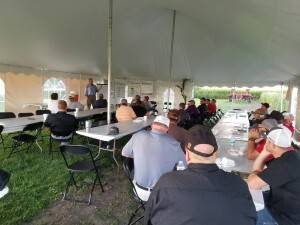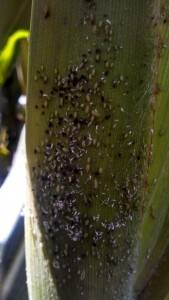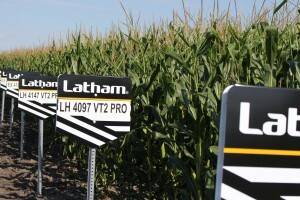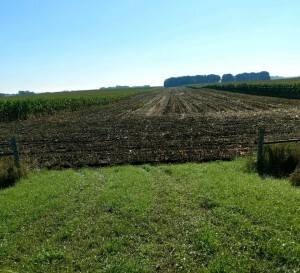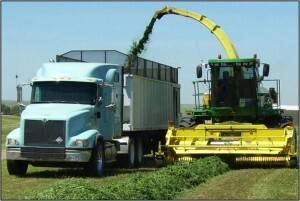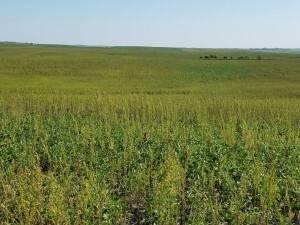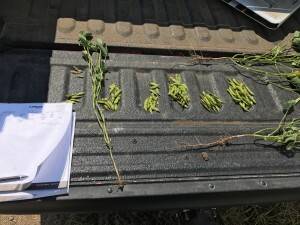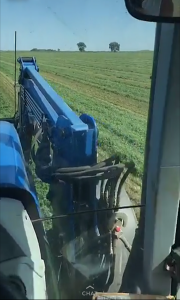Northeast Iowa & Southeast Minnesota
Craig Haaland
This week’s crop report is a “mixed bag.” The good news is we’ve received moisture, but temperatures have been cooler than normal. The month of August brought lots of cool temperatures, so let’s hope early September is usually warm!
Soybeans are looking pretty good, but they could really use some heat. This field of soybeans in Mitchell County was planted to our popular L 2084 R2. As you can see, there 4-bean pods in there.
Eastern Iowa
Jerry Broders
John McGillicuddy, independent agronomist, addresses the group at our South English, IA field day last night. Thanks John for coming to speak to our dealers and customers!
North Central Iowa & South Central Minnesota
Cory Greiman
Scouting crops all season long is especially important because different insect and disease pressures become evident at this time of year. Any type of stress greatly enhances the likelihood of opportunistic insects such as corn leaf aphids, European corn borer and army worm to feed upon plants. This week I noticed corn aphids in a field near Estherville.
Central Iowa
Bryan Rohe
It’s that time of year when farmers ask themselves what they can do differently to improve yield for the next season. Seed selection is certainly a major factor – some some might argue it’s the most important consideration – to increasing yield. Soil fertility and reducing weed pressure also are among the Top 10 Tips for increasing yield.
I am encouraging farms to look at hybrids that either have a strong drought score or to plant Genuity® DroughtGard® hybrids from Latham Hi‑Tech Seeds in 2018. The longer you can keep plants alive, the more ability they have to do their job. Health corn dies from the ground up, so I’m sure we’ll see an ROI on fungicides this year due to keeping plants health long enough to finish their jobs.
Good plant health is also key to increasing soybean yields. Sudden Death Syndrome (SDS) is starting to show up in Central Iowa soybean fields. The time is right to start watching any side by sides with ILevo and without ILevo. Also, it is a good time to make notes for future years seed treatment plans if SDS is showing up in your fields.
Soybean product selection is key. Prevention is the best defense against SDS. Soybean Cyst Nematodes (SCN) are associated with SDS. The best way to combat SCN is to plant resistant varieties or avoid susceptible varieties. Be sure to keep Latham IRONCLAD™ soybeans in mind when mapping out which varieties will be used on different fields for 2017.
The time is right to also start noting results from studies using ILeVO treated seed. Latham Seeds’ research staff to conduct 2016 studies using ILeVO treated seed side-by-side with seed that was not treated with ILeVO. We saw an average yield advantage of 3.64 bushels per acre across 26 plots, so ILeVO definitely provided a return on the investment.
West North Central Iowa
Bart Peterson
Silage harvest is underway near Alta, Iowa.
Producers often ask what the most important characteristics are when selecting corn hybrids for silage or grain. To pick the best hybrids for his situation a farmer should follow 3 basic steps: (1) Consider the end use first; (2) Keep crop rotation in mind; and (3) Minimize yield-limiting factors.
Click here for more silage selection details from Latham Forage Products Manager Corey Catt.
Northwest Iowa
Latham® Dealer Brian Schafer and his son, Adam, prepare for area farmers to show up to their Latham Hi‑Tech Seeds plot tour.
Everthing is looking good here in Northwest Iowa. The ear in the center is LH 5505 VT2 PRO, which has looked consistent in Latham’s SuperStrip plots all season long. I’m really looking forward to seeing yield results this fall!
Western Iowa & Eastern Nebraska
Larry Krapfl
Last silage crop of the year being harvested near Emerson, Nebraska. Click here if you would like tips for selection corn silage products for next year!
Southern Wisconsin
Greg Mair
The Latham Technology Tour stops in Platteville, Wisconsin tonight, Aug. 30. The plot is located at 3775 State Road 80 between Platteville and Cuba City. Tours are at 5:30 and 6 pm. We’re excited to offer our customers so many options in our lineup for 2018! We would love to see you there.
Despite not having the desired heat units, the corn is still moving along. LH 5245 VT2 PRO appears to have great yield. With ears of 16×33 and 16×36 planted at over 36,000 plants per acre (ppa), it’s sure to catch your eyes this fall.
Eastern North Dakota
Brian McNamee
Is this some new type of nurse crop?
This season, across my territory in North Dakota, I have been taken aback by the number of semi-resistant or fully-resistant weeds I have been seeing. I had no idea that marestail was as bad as it is and spread so far west. This particular field is the worst infestation I have ever seen. You can just barely make out the soybeans planted in this field.
A full grown marestail can have upwards of 200,000 seeds per plant. Just think of how many seeds are in this field… Crazy!
This year was the perfect storm for these issues to arise: pre-emergence not working; droughty conditions with slow and poor seed emergence; and periods of late-season rains that produced flushes of all weeds.
This now has the potential to be an epidemic problem not only for this farmer but all the adjacent landowners, as well. It’s going to be a challenge and will have to be monitored especially closely.
Herbicide rotation is important, but mixing herbicides with different sites of action makes weed resistance 83 times less likely to occur. Click here to learn more about weed management, including how and why herbicide resistance occurs.
Southeast North Dakota
Gary Geske
Despite very dry conditions on the Red River Valley, the corn and soybean plots we viewed at the plot day are still in good condition.
Northeast South Dakota
James Keltgen
Another widespread rain event this week will benefit the crops. Early corn is denting and converting to starch. Soybeans are filling pods. Early soybeans are beginning to yellow, signaling harvest just around the corner.
Southeast South Dakota
Ramie Coughlin
With all the rain we’ve been getting, growers are getting a nice 2nd and some 3rd cuttings of alfalfa and hay.
Northern Minnesota
Ken Highness
Congratulations to Latham rep Ryan Skaug of M&R Seed for hosting a successful plot day yesterday in Beltrami, Minnesota! The main topics of discussion among growers in attendance was weed management plus corn and soybean technologies.
Weed management is certainly more challenging! Plants that develop resistance to herbicides are simply following the age-old process of “survival of the fittest.” That’s why seed product selection and herbicide rotation are more important than ever.
Southern Minnesota
Brandon Wendlandt
Latham 2084 R2 is looking great in southern Minnesota! Now is a great time to scouting soybeans for things White Mold and Sudden Death Syndrome. The best defense is a great offense! Be sure to note problem areas and look at disease ratings when selecting future products. Also know that IRONCLAD soybean products are exclusively available from Latham Hi‑Tech Seeds.

